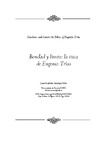Bondad y límite: la ética de Eugenio Trías

Use este enlace para citar
http://hdl.handle.net/2183/24564
A non ser que se indique outra cousa, a licenza do ítem descríbese como Creative Commons Reconocimiento 4.0 Internacional (CC BY 4.0)
Coleccións
- Investigación (FFIL) [885]
Metadatos
Mostrar o rexistro completo do ítemTítulo
Bondad y límite: la ética de Eugenio TríasTítulo(s) alternativo(s)
Goodness and Limit: the Ethics of Eugenio TríasAutor(es)
Data
2019Cita bibliográfica
SUCASAS PEÓN, J. A. "Bondad y límite: la ética de Eugenio Trías". En: Bajo Palabra [en línea], nº 22, pp. 21-56. ISSN 1887-505X. Disponible en: doi:http://dx.doi.org/10.15366/bp2019.22.001
Resumo
[Resumen] La filosofía del límite de Eugenio Trías propone una teoría ontológica donde se distinguen tres cercos (del aparecer, hermético y limítrofe) y cuatro barrios de la «ciudad fronteriza» (filosófico, religioso, estético y ético). Este texto explora el último de ellos. Analiza la ética como acontecimiento en el que intervienen tres clases de subjetividad: el sujeto 1 (emisor de la orden), el sujeto 2 (receptor) y el sujeto 3 (agente). Por otro lado, esa concepción ético-metafísica es remitida a una inspiración religiosa, la del Israel bíblico, y relacionada con la experiencia contemporánea de la barbarie. [Abstract] The philosophy of the limit of Eugenio Trías proposes an ontological theory
where three areas [cercos] are distinguished (of the appearance, hermetic and bordering) and four neighborhoods of the border city (philosophical, religious, aesthetic and ethical). This text explores the last of them. It analyzes ethics as an event in which three classes of subjectivity intervene: subject 1 (issuer of the order), subject 2 (receiver) and subject 3 (agent). On the other hand, that ethical-metaphysical conception is remitted to a religious inspiration, that of biblical Israel, and related to the contemporary experience of barbarism.
Palabras chave
Límite
Ética
Metafísica
Judaísmo
Barbarie
Limit
Ethics
Metaphysics
Judaism
Barbarism
Ética
Metafísica
Judaísmo
Barbarie
Limit
Ethics
Metaphysics
Judaism
Barbarism
Versión do editor
Dereitos
Creative Commons Reconocimiento 4.0 Internacional (CC BY 4.0)
ISSN
1887-505X






